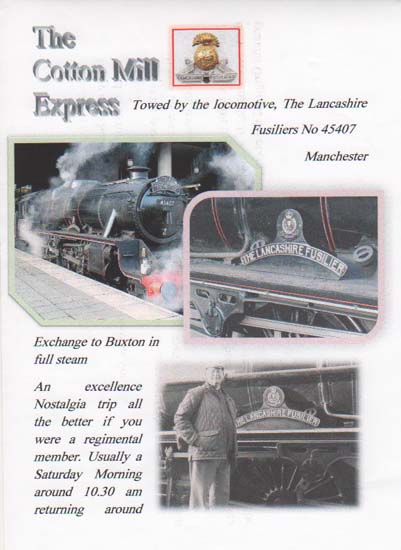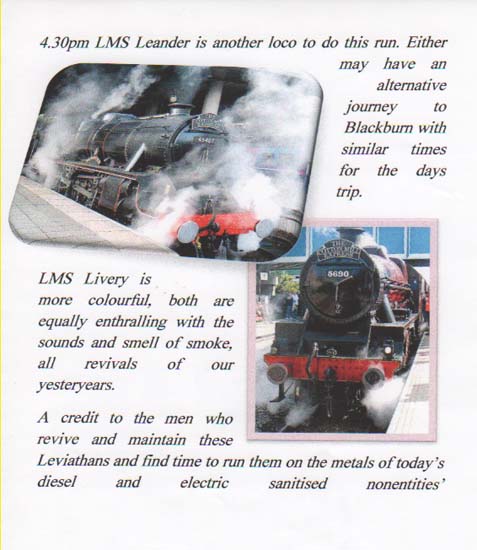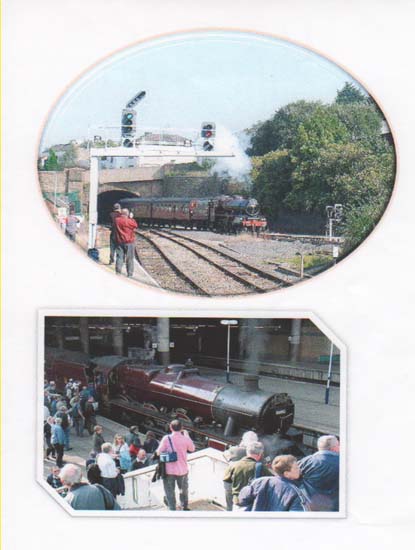
|
The History |
Click on any of the photos or newspaper
articles below to see an larger version
|
Hi Joe, Just thought I would drop you an e-mail regarding Lancaster Fusilier Steam Locomotive. By chance I came across it at Grosmont North Yorkshire railway which is 20 minutes drive from my home village. Please find photos attached. Trust you are keeping well. With best wishes and regards Mike Jefferson |
|
The Lancashire Fusilier loco was busy again last
week end 23rd /24th July 2011
Hi Joe,
I heard that 45407 was doing a run from Carlisle to York on Sunday, so I thought I would take a look. I went to Shipley and here are the photos, Chunky Moore |
|
This Story was sent in by George Peak ( Droylsden
Branch )
   |
|
Sunday, April 12, 2009 |
|
A ROYAL SCOT
IN THE LANCASHIRE FUSILIERS
In December 1926 the directors of the L.M.S. Railway
Company ordered that 50 locomotives be built straight from the drawing
board. It was the intention that they would be ready for the 1927 summer
service. The L.M.S. workshops could not hope to build this many in such
a short time, consequently the order was placed with the North British
Locomotive Company of Glasgow, which had two large plants, one at Hyde
Park and the other at Queen's Park. The building of the Royal Scot Locomotives,
as they had been designated, was split equally between the two plants.
They were allocated numbers 6100 - 6149. It is the engines built at
the Queens Park plant that interest us, in particular No. 6119. This
was released as per the photograph below which depicts number 6100;
this would later be named Royal Scot. LANCASHIRE FUSILIER shows off its new smoke deflectors,
(fitted in Jan 1932) as it pokes out its nose from the shed at Perth. Note the three lamps on the buffer beam and one in the upper centre of the smokebox door this code was used to designate Royal Trains. William Stanier had already made detail changes in the design of the Royal Scot Engines, since becoming Chief Mechanical Engineer of the L.M.S. in Jan. 1932, one being the introduction of a 4000 gallon, 9 ton tender in July 1936. More drastic changes were to happen. In September 1944, 6119 LANCASHIRE FUSILIER was rebuilt
with a Stanier taper boiler, double chimney and retaining the 4000 gallon
tender. The photograph below shows off the aesthetic lines of the re-built
engines, which would gain the reputation of becoming one of the finest
4-6-0 designs on British railways. We look at the final form of LANCASHIRE FUSILIER
fitted with its British Railway designed smoke deflectors in Sept. 1949.
Not a feature that enhanced the look of the engines.
A number of the nameplates can be seen at the Lancashire
Fusiliers Museum Bury.
Then of course we have the recent re-naming and dedication of a Metrolink Tram. These are stories for others to write. (Over to you Norman) Arnold Cragg |
The Latest Lancashire Fusilier Locomotives